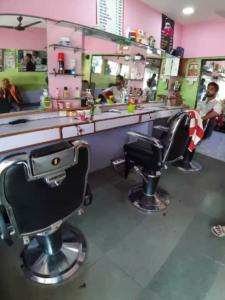Mold Remediation is the process of removing and cleaning affected building materials and contents. This includes addressing the source of moisture and mycotoxin contamination.
The first step is establishing containment. This involves sealing off the affected area and using negative air pressure to prevent mold spores from spreading. Click https://www.allproutah.com/ to learn more.

Next, the professionals will decontaminate the surfaces. They will spray them with an EPA-approved biocide that will kill the mold and make it sterile.
During the initial inspection, the mold remediation company will use various tools to identify any visible signs of mold damage and detect hidden moisture sources. This information will help formulate a strategy to eliminate the mold and address the source of the moisture that led to it.
Once the assessment has been completed, the professionals will begin the cleaning process. They will start by removing any building materials that have been affected by mold, such as drywall and carpeting. Then they will clean non-porous items like metals, glass, and plastics using a commercial-grade antimicrobial solution. The professionals will also use EPA approved biocides on porous materials to kill any remaining mold spores and prevent them from spreading.
The next step is to dehumidify the area. This will help the building materials and any discarded items dry out. In most cases, this step will take several days. The professional will use fans or dehumidifiers to speed up the drying process and will also wipe down the surfaces of any contaminated items.
This is a crucial step because any remaining moisture can cause the mold to return. Moisture can be from water or condensation, so it is important to remove it as quickly as possible. Once the moisture is removed, a mold remediation specialist will inspect the building and the impacted items again to ensure that all the spores have been eliminated.
If any spores are left behind, they can spread to other areas of the home. This is why it is important to dehumidify the entire building.
Once the spores are eliminated, the building will need to be sanitized. This is a very delicate process and is done by removing any porous items that have been contaminated by the mold, such as carpeting and drywall. The professionals will then use a disinfectant to sanitize the affected materials and air.
It is crucial that the sanitization process be thorough because mold spores are extremely small and can travel through air vents. This is why it is important to have a good quality air filtration system in your home.
Cleaning the Area
This step removes the existing mold spores and prevents them from returning. It involves scrubbing and cleaning surfaces and sanitizing the air with HEPA filters and antimicrobial agents. This includes non-porous materials like walls, ceilings, floors, and countertops. It also involves cleaning and sanitizing belongings that may have been in contact with the spores. This includes furniture, clothing, and personal items. The area is then dried and dehumidified to help prevent future problems.
During this stage, it’s important to keep the impacted area as isolated as possible from the rest of the house. To do so, professionals may use plastic sheeting to create a barrier around the affected areas. They may also install fans and dehumidifiers to prevent the spread of spores and moisture. If there’s any way to cut off the water source, this should be done as well.
Non-porous items that have been contaminated by mold and other moisture are removed and discarded. This can include drywall, carpeting, insulation, and wood floors. If these items can’t be saved, they are thrown away and replaced with new materials that have been treated to kill any remaining mold spores.
Porous materials that can’t be removed, such as wooden wall studs and window sills, will likely be sprayed with an EPA-approved biocide to kill the mold spores and prevent further growth. If necessary, the surface will then be sanded or blasted with dry ice or media blasting.
Mold spores are spread by airborne particles, so if a homeowner or occupant has respiratory issues, it’s important to wear protective gear during this step of the process. This includes masks, goggles, and gloves. It’s also a good idea to keep the windows open and to ventilate the space during this time.
Before the cleanup is complete, the area will be tested to make sure the humidity level meets certain standards. If it doesn’t, mold spores can start growing again and the remediation process will have to be repeated.
Disposing of the Materials
Mold Remediation involves several stages: identifying the type and extent of the mold, containing the spread of mold spores, cleaning and disinfecting the area, and restoring the room. During the first step, professionals identify and locate the mold and the water source with tools like moisture meters and infrared cameras. This will help them devise a remediation plan that addresses the conditions that allow mold to grow.
The next stage is removing contaminated materials. This may include tearing down walls and carpeting, as well as disposing of porous materials like drywall and insulation. This step is especially important if the mold is severe or has been there for a long time, as it can be difficult to remove from deep within porous material.
When removing these materials, mold remediation experts use containment and air filtration devices to keep the spores from spreading to other parts of the home. Once the removal is complete, the area must be thoroughly cleaned and disinfected. This can be done by using a variety of methods, including spraying EPA-approved biocide on non-porous surfaces and using commercial-grade antimicrobial sprays on porous materials like wooden wall studs.
During this process, it is important to keep humidity levels below 50%, as mold thrives in damp areas. Fans and dehumidifiers can help control the moisture level and speed up the drying process. Once the surface is clean, it must be allowed to dry completely before mold spores are re-introduced into the air. This can be done by using fans and a dehumidifier, as well as wiping and disinfecting the affected areas.
Any items that are unable to be cleaned, such as stuffed animals or draperies, should be sealed in plastic bags and removed from the area during this process. Any cleaning materials that are used in the contaminated areas must be sterilized with a sporicidal agent before being reused. This can be done by using methylene chloride or a non-chemical biocide such as detergent.
Depending on the scope of the project, it may be necessary to dispose of any items that are beyond repair or restoration, as well as all contaminated cleaning materials and equipment. This can be a very costly step, especially if there is a large amount of material to be disposed of. If this is the case, it is important to contact a hazardous waste company that can safely transport and dispose of these materials.
Restoring the Area
Mold spores float in the air and can easily enter your home or business through open doors or windows, or even hitch a ride on your clothes or pets. The best way to deal with the issue is to prevent it from occurring in the first place. Mold prevention involves making sure that your house is dry, all materials are clean and that there is proper ventilation to keep humidity and moisture levels low.
During the cleaning phase of a mold remediation, the affected area will be contained in plastic or polyethylene sheeting that will help to contain the mold spores from spreading. Some teams will also use filtration systems to control the movement of airborne spores within the impacted areas and will disinfect surfaces and items that cannot be removed (including drywall, insulation, carpeting, etc.).
If you have any items that you want to save, such as furniture or other possessions, a contents pack out will occur during the restoration process. This consists of the restoration company packing up all of your saveable belongings, such as textiles, hard goods, photographs, electronics and more, and taking them off site to be restored or cleaned. Depending on the items, this may be done near the beginning or towards the end of the restoration process.
When the restoration process is complete, a trained and certified mold inspector will re-inspect the area to make sure it is completely cleaned and safe to return to occupancy. They will check humidity and moisture readings, as well as visual cues to ensure that the mold has been completely eliminated. They will also test airborne spore samples inside and outside the affected area to confirm that the process was successful and that the area is clear of mold.
Mold Remediation is a long process, but it is one that is necessary to ensure your safety and the health of those living in your home or business. It is best to contact an IICRC certified restoration company to handle the initial inspection and testing, as they will be able to provide you with all the information and guidance that you need to get started.








